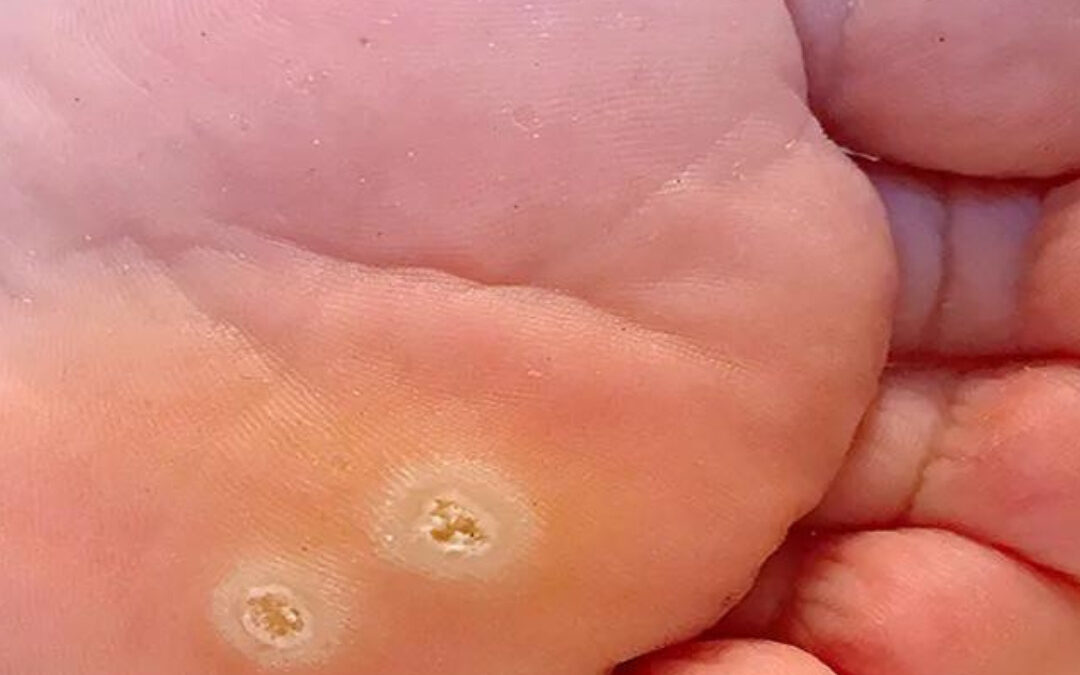What is a Verruca?
Verrucae are usually found on the bottom of the foot and is a small skin lesion usually around 1cm in diameter.
Usually associated with children, verrucae are also a common complaint amongst adults.
What causes it?
All verrucae are caused by the human papilloma virus which is common in all environments but does not readily attack the skin. Due to this though verrucae are commonly contracted in communal places such as swimming pools, showers and changing areas, therefore children are more at risk of contracting verrucae in school changing rooms and swimming pools.
If there is excessive moisture or excessive dryness of the skin this can lead to small cracks in the skin which allows the virus to enter.
What will happen if I leave it untreated?
Most of the time Verrucae will heal on their own if left alone however they can easily spread so if the verruca is touched or scratched a sufferer must wash their hands straight away or it can spread to other parts of the body.
What can help?
To avoid verrucae, try to avoid touching other people’s verrucae and that hands are washed if a verruca is touched. It is also best to avoid sharing towels, flannels, shoes, and socks with other people and to make sure that feet and hands are kept clean and dry.
Due to how the virus spreads it is best to avoid going barefoot in public places and communal areas.
Also, if contracted avoid scratching or picking at the verrucae this may spread the infection to other parts of the body.
What are the treatment options?
Verrucae can be treated in a relatively wide variety of methods
In terms of selecting the best treatment for verrucae there are three fundamental questions.
1. What is the verruca like?
2. What is the patient’s expectation?
3. What is the practitioner’s remit?
Verrucae come in all shapes and sizes and about half a dozen different viral subtypes.
The most important part of the equation, the patient. How much is it hurting? How much do they want rid of it? WHY do they want rid of it? Whats their tissue viability like? What, in fact, do they want?
What is the Practitioner’s remit? The options open to Foot Health Practitioner are different to those available to a pod surgeon.
So with that all said, in very broad strokes, all the treatments work about the same way, by triggering an immune response to the virus. Most do this by causing tissue damage to trigger inflamation. And generally, the more tissue damage you do, the better the chance of resolution.
This is not an exhaustive list but in general terms…
- Do nothing. No risk, no cost, background chance the lesion will self resolve. A good option for painless lesions which don’t worry the patient.
- Occlusion with tape. Minimal risk, minimal cost, minimal chance to resolve the lesion, excellent chance to keep it comfy. Good if the patient’s main concern is pain.
- Home caustic use, (sal acid). Will make it more painful for the duration, circa 30 -40% chance of getting rid within 6 months or so.
- More concentrated caustics used in clinic. Similar to 3 but with more control over how it is applied. May have a better success rate
- Cryotherapy. Similar success rate to 3. Hurts a lot if its done well. The Practitioner controls the amount of damage.
- Verrutop. Still new so data not really there yet but seems to be similar or slightly better than sal acid, but with fewer applications and less pain. Costs more and needs patient to keep coming back in. Circa 50% success rate (Manufacturer’s claim).
- Needling. circa 60%-70% success rate with 3 treatments. Needs a local anesthetic and its a surgical proceedure, however it does not create an open wound as such.
- Blunt dissection/curretage. Again, a surgical treatment with local anesthetic. If its a discrete lesion it can be scooped out. Like removing a corn this gives immediate relief once the wound heals, but like everything else here, it can still grow back if the immune response is not triggered.
- Swift. New machine. Emits microwaves to cook the lesion. Hurts quite a bit but does not need local anesthetic. Success rate is reported to be similar to needling, but again its a new treatment so still waiting on the data. Likely to be expensive.

